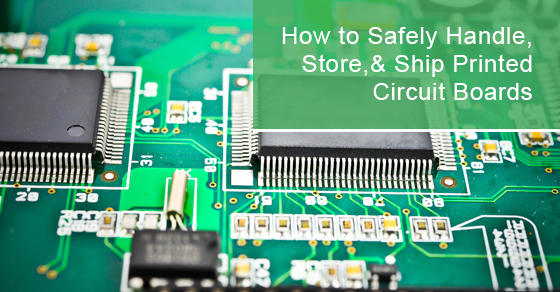How to Safely Handle, Store, & Ship Printed Circuit Boards
Your business spends a lot of energy, time, and money developing your products. If you rely on printed circuit boards as an essential part of what you sell, you want to guard that investment.
Printed circuit boards may appear to be made of strong materials, which they are, but they are delicately crafted together. One bump or crash and a vital circuit component could be knocked out of place. If your printed circuit board is not intact, it can’t do its job, and your product will fail.
You should discuss packaging and shipping practices with your manufacturer to prevent this from happening. You’ll want to ensure that your printed circuit board is properly protected. After all, not all damage is visible but can hurt your productivity.
Importance of Printed Circuit Board Packaging and Shipping
It might seem silly to be obsessive over something like the packaging of your printed circuit board. After all, so long as it arrives in one piece and functioning, what’s the big deal?
Consider the time and effort you put into designing and developing your circuit board. The packaging that the printed circuit board is shipped in will protect it. And it will ensure that it gets there safely. After all, you’ve invested a lot of time crafting a circuit board that will be safe in its operating environment. Spending a little time ensuring that the packaging will keep your printed circuit board safe during shipping helps to protect your work.
There are many different ways that a printed circuit board can be damaged during the shipping process, such as:
- Crushing
- Dropping
- Shaking
- Temperature
- moisture
Packages are at the mercy of the person who handles them, and there could be many people along the shipping process who don’t treat your printed circuit board package as gently as you’d like. Your parcel may experience some bad handling along its journey.
It’s best to be prepared, plan for the worst, and hope for the best. By taking some time and putting thought into the packaging your printed circuit board will be housed in, you’ll be able to avoid disappointment and aggravation when it arrives.
Handling Printed Circuit Board Assembly
A key rule for printed circuit boards is to handle them as little as possible. Rather, use trays and carts to move them around. If PCB assembly calls for hands-on work, wear gloves.
If you need to transport the board between stations during PCB assembly, use a protective bag to prevent damage. You should also meticulously clean each station often. This can help prevent debris from getting on the board and causing damage.
When working on the PCB assembly line, avoid hand lotions or other similar applications. These can transfer to the board, causing problems.
Avoid PCB assembly where there are items that can cause static, such as carpets, rugs, etc. This can also cause damage to the board.
Tips for Storing PCBs
PCBs are delicate electrical components and need special care and attention. Any minimal change in the environment can cause problems with a board. Moisture, heat, and cold air can damage a PCB, so you need to be cautious about where you are storing your PCBs. Without proper storage, your PCB could warp, short out, or come in contact with mould. Other dangers include animals, dust, chemicals, and more.
Due to these challenges, PCBs should be stored in warm, dry spaces with a consistent temperature and minimal humidity. You can use barrier bags or similar packaging types to provide optimal protection. It’s also best not to store PCBs for long periods.
Types of Printed Circuit Board Packaging
The packaging you’ll want to use will depend on the PCB assembly and what shipping risks you wish to guard against. Here are some of the most common types of PCB packaging.
Tissue Paper/Bubble Wrap
Tissue paper or bubble wrap is the bare minimum you’ll want to use in your packaging. It will work if you have a very strong and simple PCB. However, if you have more complex components, you’ll want to use something more robust to protect your board.
Pink Poly
This plastic wrap provides extra protection for ESD. You’ll be able to find it as bags, bubble wrap, and plastic wrap. A bonus of using pink poly for your PCB is that it can protect against shocks when packing and unpacking the box. However, it should not be used with certain plastic materials, such as polycarbonate. So, if your PCB has any in its components, you’ll need to find another packing solution.
ESD Bags
An ESD bag might be the best packing choice if you have sensitive ESD components. They come in various sizes. You should have your ESD sharp boards put into separate bags to prevent static shocks during shipping. Oversized hardware can also be shipped in ESD bags.
Moisture Barrier Packages
Keeping moisture away from your PCB is a must and something you should consider if your circuit board will be going in a humid climate or overseas. In bags and packages with a moisture barrier, your PCB will be placed individually with some desiccant to keep it dry during travels. An additional bonus of moisture barrier packages is that they can resist punctures. This provides extra protection for your PCB.
Vacuum Sealed
If you have a particularly sensitive PCB, you can opt for vacuum-sealed packaging. This type of shipping packaging will have all the air removed before it’s sealed. It will look similar to shrink wrap.
For more information about care and storage for your PCBs, call Circuits Central at 1-800-602-7264 or contact us here.

